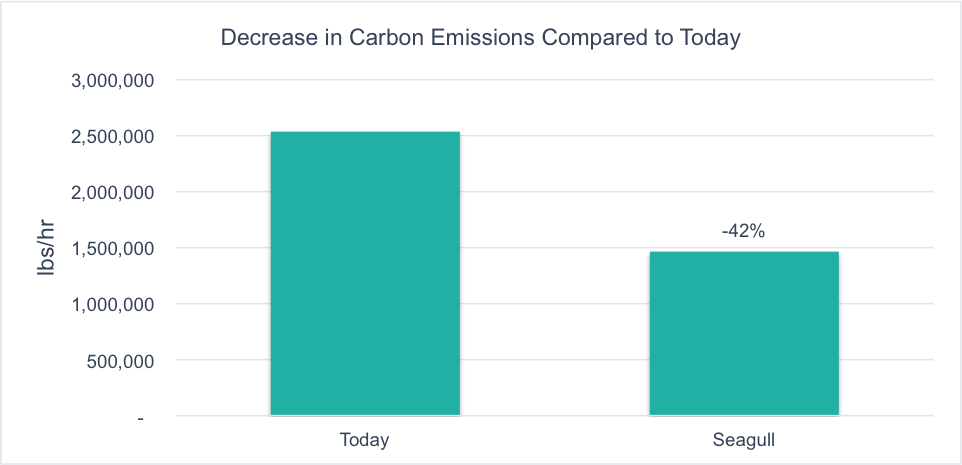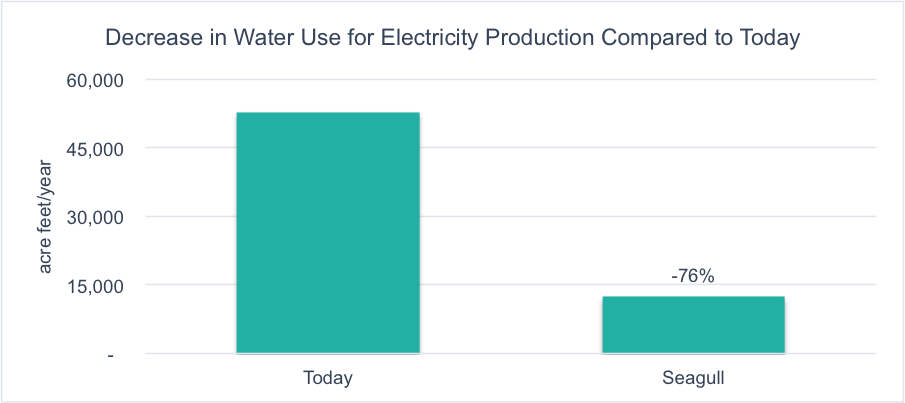The Story
By 2050, the primary source of our electricity transitions from coal to natural gas due to environmental rules concerning emissions from coal-fired power plants. Utahns use 30% less electricity per person than today as a result of energy efficiency and conservation measures. Natural gas produces about half of the electricity we use, and renewables, such as wind and solar, increase to about a fourth. This scenario reflects Rocky Mountain Power's most recent projections and is based on the most economical resource mix. (Under all scenarios, natural gas production increases for electricity generation and for residential, commercial, and industrial uses as the number of homes, businesses, and buildings nearly doubles.)
Results
- Household costs remain low; only 3% increase from what we pay today.
- 42% decrease in carbon dioxide emissions.
- 29% decrease in air pollutants such as NOx and SO2 (emissions occur outside Wasatch Front).
- 76% decrease in the amount of water used to produce electricity.
- Heavier reliance on one fuel source—natural gas—makes us susceptible to energy supply disruption and price spikes.





Background
Utah is an energy-rich state. We have reserves of natural gas and coal and potential for renewable energy supply from solar, wind, and geothermal energy. Utah’s total energy production in 2012 was approximately 1.14 trillion Btu. Because Utah produces more energy than it consumes, surplus energy is exported. In 2011, 31% of all energy produced in Utah was exported, including 27% of the state’s electricity. The Utah Office of Energy Development estimates that in 2013, the market value of Utah’s energy sources and renewable electricity was $5.3 billion.
Most Utah communities are customers of Rocky Mountain Power and receive their electricity from power generation facilities in several states. In 2009, residents, businesses, and industries used approximately 27,400 gigawatt hours of electricity. Currently, the price of residential electricity in Utah is among the lowest in the nation at about 10.72 cents per kilowatt hour (kWh). In comparison, the price for electricity is 17.05 cents/kWh in California and 19.46 cents/kWh in New York. Our comparatively low energy costs make us attractive to business and industry.
Today, most of Utah’s electricity is generated from coal-fired power plants, but Rocky Mountain Power is increasing the use of other energy sources like natural gas and renewables such as wind and solar. No coal-fired power plant has been built in Utah in the last quarter century. There are no plans to build any new coal-fired plants, and those that exist are planned to be retired. Fossil fuel-fired power plants are currently the largest source of carbon dioxide (CO2) emissions in the United States, accounting for 38% of U.S. total greenhouse gas emissions in 2013. Natural gas plants produce substantially less CO2 emissions than do coal plants.
The natural gas industry in Utah is growing, due in part to the electric power sector’s transition away from coal. Utah ranked tenth in the nation in natural gas production in 2012. Of the natural gas consumed in Utah in 2013, the residential sector used 35%, electric power generation used 25%, the commercial sector used 21%, and the industrial sector used 19%. Only 0.2% of natural gas consumed was used as fuel for vehicles. The price of natural gas in Utah remains low compared to the rest of the nation with residential natural gas costing an average of $8.55/thousand cubic feet in 2013.
As Utah’s population doubles, our energy needs will increase. Despite our many energy resources, Utah will likely use significantly more natural gas for electricity, for space and water heating in homes and commercial buildings, and for industrial uses.


